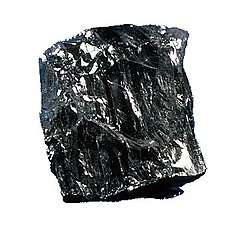Sub-bituminous coal
Sub-bituminous coal is a type of coal whose properties range from those of lignite to those of bituminous coal and are used primarily as fuel for steam-electric power generation.
Properties
Sub-bituminous coals may be dull, dark brown to black, soft and crumbly at the lower end of the range, to bright jet-black, hard, and relatively strong at the upper end. They contain 15-30% inherent moisture by weight and are non-coking (undergo little swelling upon heating).[1] The heat content of sub-bituminous coals range from 8300 to 11,500 BTu/lb or 19.3 to 26.7 MJ/kg. Their relatively low density and high water content renders some types of sub-bituminous coals susceptible to spontaneous combustion if not packed densely during storage in order to exclude free air flow.
Reserves
A major source of sub-bituminous coal in the United States is the Powder River Basin in Wyoming.
Current use
Sub-bituminous coals, in the United States, typically have a sulfur content less than 1% by weight, which makes them an attractive choice for power plants to reduce SO2 emissions under the Acid Rain Program.
See also
- Types of Coal
- List of CO2 emitted per million Btu of energy from various fuels
References
- The Babcock & Wilcox Company. Steam: its generation and use. The Babcock & Wilcox Company. pp. 36–5. ISBN 0-9634570-1-2.
